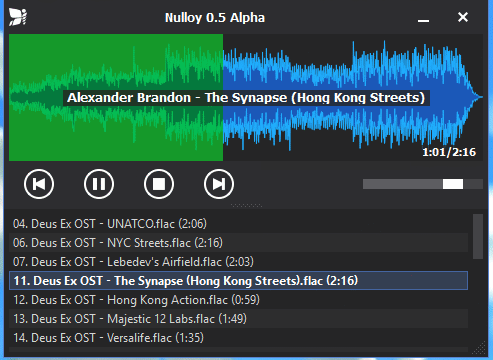|
IPod Shuffle
The iPod Shuffle (stylized and marketed as iPod shuffle) is a discontinued digital audio player designed and formerly marketed by Apple Inc. It was the smallest model in Apple's iPod family, and was the first iPod to use flash memory. The first model was announced at the Macworld Conference & Expo on January 11, 2005; the fourth- and final-generation models were introduced on September 1, 2010. The iPod Shuffle was discontinued by Apple on July 27, 2017. Overview 1st generation Released on January 11, 2005, during the Macworld/iWorld, Macworld expo, the first-generation iPod Shuffle weighed , resembled a pack of chewing gum sticks, and was designed to be easily loaded with a selection of songs and to play them in sequential or random order. It used the SigmaTel STMP35xx system on a chip (SOC) and its software development kit (SDK) v2.6, a flash memory IC, and USB rechargeable lithium cell. The STMP35xx SOC and its software was the most fully integrated portable MP3 playback ... [...More Info...] [...Related Items...] OR: [Wikipedia] [Google] [Baidu] |
System On A Chip
A system on a chip (SoC) is an integrated circuit that combines most or all key components of a computer or Electronics, electronic system onto a single microchip. Typically, an SoC includes a central processing unit (CPU) with computer memory, memory, input/output, and computer data storage#Secondary storage, data storage control functions, along with optional features like a graphics processing unit (GPU), Wi-Fi connectivity, and radio frequency processing. This high level of integration minimizes the need for separate, discrete components, thereby enhancing Performance per watt, power efficiency and simplifying device design. High-performance SoCs are often paired with dedicated memory, such as LPDDR, and flash storage chips, such as Universal Flash Storage, eUFS or eMMC, which may be stacked directly on top of the SoC in a Package on a package, package-on-package (PoP) configuration or placed nearby on the motherboard. Some SoCs also operate alongside specialized chips, such ... [...More Info...] [...Related Items...] OR: [Wikipedia] [Google] [Baidu] |
PC Magazine
''PC Magazine'' (shortened as ''PCMag'') is an American computer magazine published by Ziff Davis. A print edition was published from 1982 to January 2009. Publication of online editions started in late 1994 and continues . Overview ''PC Magazine'' provides reviews and previews of the latest hardware and software for the information technology professional. Other regular departments include columns by long-time editor-in-chief Michael J. Miller ("Forward Thinking"), Bill Machrone, and Jim Louderback, as well as: * "First Looks" (a collection of reviews of newly released products) * "Pipeline" (a collection of short articles and snippets on computer-industry developments) * "Solutions" (which includes various how-to articles) * "User-to-User" (a section in which the magazine's experts answer user-submitted questions) * "After Hours" (a section about various computer entertainment products; the designation "After Hours" is a legacy of the magazine's traditional orientation to ... [...More Info...] [...Related Items...] OR: [Wikipedia] [Google] [Baidu] |
IPod Classic
The iPod Classic (stylized and marketed as iPod classic and originally simply iPod) is a discontinued portable media player created and formerly marketed by Apple Inc. There were six generations of the iPod Classic, as well as a spin-off (the iPod Photo) that was later re-integrated into the main iPod line. All generations used a hard disk drive, hard drive for storage. The "classic" suffix was formally introduced with the rollout of the sixth-generation iPod on September 5, 2007. Prior to this, all iPod Classic models were simply referred to as iPods; the first iPod released in 2001 was part of this line that would be called "Classic". It was available in silver or black from 2007 onwards, replacing the "signature iPod white". On September 9, 2014, Apple discontinued the iPod Classic. The sixth-generation 160 GB iPod Classic was the last Apple product to use the original Dock connector#30-pin dock connector, 30-pin dock connector and the distinctive iPod click wheel, click w ... [...More Info...] [...Related Items...] OR: [Wikipedia] [Google] [Baidu] |
Bass (sound)
Bass ( ) (also called bottom end) describes tones of low (also called "deep") frequency, pitch and range from 16 to 250 Hz (C0 to middle C4) and bass instruments that produce tones in the low-pitched range C2-C4. They belong to different families of instruments and can cover a wide range of musical roles. Since producing low pitches usually requires a long air column or string, and for stringed instruments, a large hollow body, the string and wind bass instruments are usually the largest instruments in their families or instrument classes. Musical role When bass notes are played in a musical ensemble such an orchestra, they are frequently used to provide a counterpoint or counter-melody, in a harmonic context either to outline or juxtapose the progression of the chords, or with percussion to underline the rhythm. Rhythm section In popular music, the bass part, which is called the "bassline", typically provides harmonic and rhythmic support to the band. The bass playe ... [...More Info...] [...Related Items...] OR: [Wikipedia] [Google] [Baidu] |
Advanced Audio Coding
Advanced Audio Coding (AAC) is an audio coding standard for lossy digital audio compression. It was developed by Dolby, AT&T, Fraunhofer and Sony, originally as part of the MPEG-2 specification but later improved under MPEG-4.ISO (2006ISO/IEC 13818-7:2006 – Information technology — Generic coding of moving pictures and associated audio information — Part 7: Advanced Audio Coding (AAC), Retrieved on 2009-08-06ISO (2006, Retrieved on 2009-08-06 AAC was designed to be the successor of the MP3 format (MPEG-2 Audio Layer III) and generally achieves higher sound quality than MP3 at the same bit rate. AAC encoded audio files are typically packaged in an MP4 container most commonly using the filename extension .m4a. The basic profile of AAC (both MPEG-4 and MPEG-2) is called AAC-LC (''Low Complexity''). It is widely supported in the industry and has been adopted as the default or standard audio format on products including Apple's iTunes Store, Nintendo's Wii, DSi and ... [...More Info...] [...Related Items...] OR: [Wikipedia] [Google] [Baidu] |
Kilobit Per Second
In telecommunications, data transfer rate is the average number of bits (bitrate), characters or symbols ( baudrate), or data blocks per unit time passing through a communication link in a data-transmission system. Common data rate units are multiples of bits per second (bit/s) and bytes per second (B/s). For example, the data rates of modern residential high-speed Internet connections are commonly expressed in megabits per second (Mbit/s). Standards for unit symbols and prefixes Unit symbol The ISQ symbols for the bit and byte are ''bit'' and ''B'', respectively. In the context of data-rate units, one byte consists of 8 bits, and is synonymous with the unit octet. The abbreviation bps is often used to mean bit/s, so that when a ''1 Mbps'' connection is advertised, it usually means that the maximum achievable bandwidth is 1 Mbit/s (one million bits per second), which is 0.125 MB/s ( megabyte per second), or about 0.1192 MiB/s ( mebibyte per second). Th ... [...More Info...] [...Related Items...] OR: [Wikipedia] [Google] [Baidu] |
ITunes
iTunes is a media player, media library, and mobile device management (MDM) utility developed by Apple. It is used to purchase, play, download and organize digital multimedia on personal computers running the macOS and Windows operating systems, and can be used to rip songs from CDs as well as playing content from dynamic, smart playlists. It includes options for sound optimization and wirelessly sharing iTunes libraries. iTunes was announced by Apple CEO Steve Jobs on January 9, 2001. Its original and main focus was music, with a library offering organization and storage of Mac users' music collections. With the 2003 addition of the iTunes Store for purchasing and downloading digital music, and a Windows version of the program, it became an ubiquitous tool for managing music and configuring other features on Apple's line of iPod media players, which extended to the iPhone and iPad upon their introduction. From 2005 on, Apple expanded its core music features with s ... [...More Info...] [...Related Items...] OR: [Wikipedia] [Google] [Baidu] |
Audio Interchange File Format
Audio Interchange File Format (AIFF) is an audio file format standard used for storing sound data for personal computers and other electronic audio devices. The format was developed by Apple Inc. in 1988 based on Electronic Arts' Interchange File Format (IFF, widely used on Amiga systems) and is most commonly used on Apple Macintosh computer systems. The audio data in most AIFF files is uncompressed pulse-code modulation (PCM). This type of AIFF file uses much more disk space than lossy formats like MP3—about 10 MB for one minute of stereo audio at a sample rate of 44.1 kHz and a bit depth of 16 bits. There is also a compressed variant of AIFF known as AIFF-C or AIFC, with various defined compression codecs. In addition to audio data, AIFF can include loop point data and the musical note of a sample, for use by hardware samplers and musical applications. The file extension for the standard AIFF format is .aiff or .aif. For the compressed format the preferred suffi ... [...More Info...] [...Related Items...] OR: [Wikipedia] [Google] [Baidu] |
Apple Lossless
The Apple Lossless Audio Codec (ALAC, ), also known as Apple Lossless, or Apple Lossless Encoder (ALE), is an audio coding format, and its reference audio codec implementation, developed by Apple Inc., Apple for lossless data compression of digital music. After initially keeping it proprietary format, proprietary from its inception in 2004, in late 2011 Apple made the codec available open-source software, open source and royalty-free. Traditionally, Apple has referred to the codec as ''Apple Lossless'', though more recently it has begun to use the abbreviated term ''ALAC'' when referring to the codec. ALAC data is frequently stored within an MPEG-4 Part 14, MP4 Container format (digital), container with the filename extension ''.m4a''. This extension is also used by Apple for Advanced Audio Coding, AAC (which is a Lossy compression, lossy format) in an MP4 container (same container, different audio encoding). ALAC can also be used by the Core Audio Format, .CAF file type container ... [...More Info...] [...Related Items...] OR: [Wikipedia] [Google] [Baidu] |
Playlist
A playlist is a list of video or audio files that can be played back on a media player, either sequentially or in a shuffled order. In its most general form, an audio playlist is simply a list of songs that can be played once or in a loop. The term has several specialized meanings in the realms of television broadcasting, radio broadcasting and personal computers. A video playlist can also be a list of recorded titles on a digital video disk (DVD). On the internet, a playlist can be a list of chapters in a movie serial; for example, Flash Gordon in the Planet Mongo is available on YouTube as a playlist of thirteen consecutive video chapters. Radio The term originally came about in the early days of Top 40 radio formats in the 1950s when stations would devise (and, eventually, publish) a limited list of songs to be played. The term would go on to refer to the entire catalog of songs that a given radio station (of any format) would draw from. Additionally, the term was ... [...More Info...] [...Related Items...] OR: [Wikipedia] [Google] [Baidu] |


